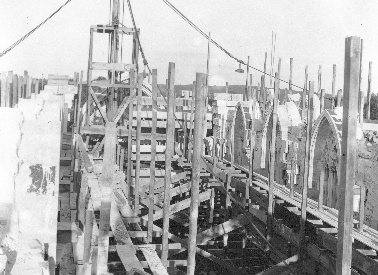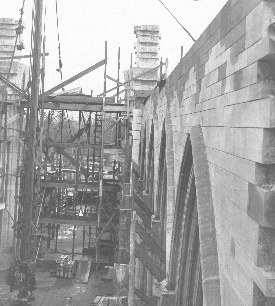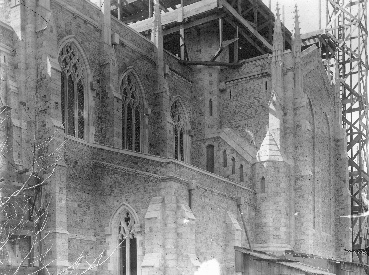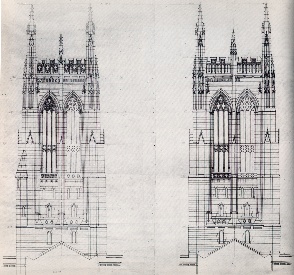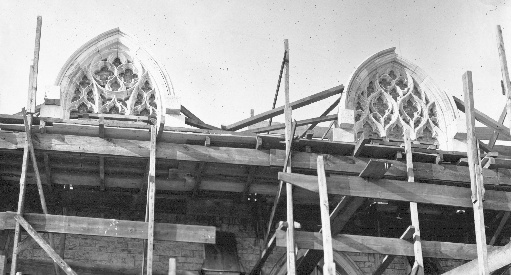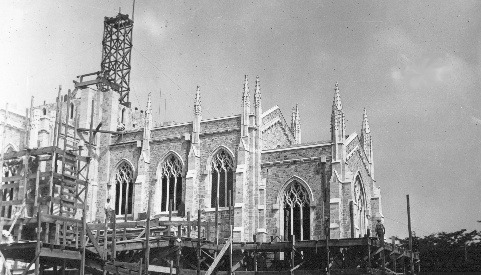Bryn Athyn Cathedral: The Building of a Church
E. Bruce Glenn
Architectural Refinements and Variations
IT HAS BEEN SAID that nature rejects the straight line. The mind, turning everywhere among the Creator's visible works, finds change, variety, complexity to be the rule, and delights in them. It is not that nature lacks a mighty unity of design; rather, the great chords of creation are a harmony of many individual notes, no two alike yet all in balance. The senses are constantly refreshed and the mind is alerted by symbols that reflect the infinite range of the Designer.
The history of architecture is one of iterated recognition and rejection of this great natural principle. The formal care of the eighteenth century, for instance, removed itself as far as possible from natural expression; its architecture was that of symmetry and rectilinear control. This was doubtless, in part, a revulsion against the luxuriant profusion which characterized the late renaissance period. Yet there is a happy path between the two extremes, which the Periclean Age had followed in its combining of repetitive simplicity with varied motif and the subtle use of curves.
What of the Gothic age? The very name suggests a rough, natural quality, reflecting a certain disdain on the part of the later culture which thus critically labeled the work of the medieval artists. And, indeed, until the time of Ruskin and later, much of what is now discovered to be purposeful beauty was regarded as accident, carelessness, or at best, the result of settling foundations.
New and documented discoveries of refinements in the cathedrals of medieval Europe were being made just as plans were being drawn for the Bryn Athyn church. Raymond Pitcairn was not yet aware of these findings; but with a strong desire for a distinctive symbolism in the building, he wrote to Cram in the summer of 1913 to ask if curves and asymmetries might be introduced. Cram, however, felt that the church as planned was too small for such optical effects. His only suggestions were an incline in the floor of the nave leading up to the chancel, unequal spacing of the nave arcade, and a declination of the chancel from the longitudinal axis. The last suggestion was rejected as traditionally representative of Christ hanging on the cross, an image which the New Christian Church finds repugnant to its worship of the risen Lord. The other two were incorporated into the structure with a happy effect that was greatly enhanced by further refinements introduced much later in the church's progress. It is these further refinements—delicatesses as the French aptly call them—that do much to set the Bryn Athyn Cathedral apart from other contemporary structures.
The outer walls of the nave were a few courses above the ground when, in the spring of 1915, Pitcairn read of a lecture on medieval churches, illustrated by large photographs, to be given in Philadelphia. The lecturer, Professor William Goodyear, formerly curator of the Metropolitan Museum in New York, and then with the Brooklyn Museum, had made a thorough study of medieval departures from rectilinear design and symmetry, and was prepared to defend them as carefully planned and remarkably executed by the old builders. Pitcairn attended Goodyear's lectures, together with two of Cram's staff assigned to the work at Bryn Athyn. As Cram had wryly predicted, they came away so enthusiastic with the possibilities for Bryn Athyn that the first of many refinements was developed on the drawing board the next day—a curve in plan of the nave arcade. ("Curves in plan" refer to horizontal departures from straight line; "bends in elevation" to vertical departures). As Pitcairn wrote gratefully to Goodyear two years later, "You see, things have a habit of just developing at Bryn Athyn, and unless one is constantly in touch with the work, it is impossible to know what is happening from day to day. In any case, after the painstaking labor of so many years, it may be of interest to you to realize that your lectures and photographs have resulted, in the case of Bryn Athyn Church, in constructive work which, although executed in this commercial age, has been undertaken and carried out in a spirit which I trust may appeal to you when you visit the church."1
View along the clerestory arcade of the nave, with the north wall directly before the camera. This shows clearly the curve in the clerestory wall, bending out and then in as it approaches the tower arch ahead, and lending the upper reaches of the nave a sense of openness. Click on image for a larger version.
Another view of the nave clerestory wall looking toward the tower piers thrusting upward with interleaving courses. Not only is the subtle curve in plan visible along this south wall; the bend upward in elevation and then down toward the tower is strikingly shown in the differing apexes of the window arches, especially when seen against the courses of the wall. Click on image for a larger version.
Goodyear's response was enthusiastically affirmative. His study of refinements was not simply that of an antiquarian; he hoped that the effect achieved by the builders of the Middle Ages might be similarly evoked by architects of the twentieth century. In his definitive article on the subject, published in the Brooklyn Museum Quarterly, October 1918, he wrote:
The object of this discussion is, therefore, to enquire whether there is a possibility of the practical application to modern churches of any or some of the refinements which have been recently found in those of the medieval period.2
Thus he asked,
how far these virtues may be revived under wholly different conditions. . . . It follows that the first practical value to modern architects . . . must be the opportunity to study the matter for themselves and to develop from that study such independent initiative as their own temperament may prompt, inspired by the confidence that they are not violating tradition in departing from mathematical and geometrical symmetry, but that they are really faithful to tradition.3
In a note accompanying this article, Goodyear described the refinements at Bryn Athyn in such terms as to leave no doubt that he regarded them as successful applications of medieval "virtues." Even before he saw the cathedral, he had hailed the work as a notable departure from current practice:
The church at Bryn Athyn is the first in modern times, or in the last 400 years, to employ curves in plan in the alignment of the arcades of the nave. . . . Not only is this church the first in modern history to employ curves in plan, but it is also the first to employ bends in elevation of the horizontals, and bends in plan of the facade.4
Let us examine these refinements with some care, so that by seeing their nature and extent we may more fully appreciate their subtle effect within the structure. It is one of the truisms of art, architecture included, that the senses and the mind may respond to certain effects without being aware of specific causes. Yet to know the nature of the cause is to be increasingly sensitive to the effect. There is a striking analogy here to one of the basic teachings of New Church doctrine, described there as a law of Divine Providence. The teaching is that man enjoys life with increased delight as his own, to the extent that he perceives and acknowledges that it is a gift from the Lord. To know this truth is to free the mind from doubt and obscurity, and thus to open unlimited possibilities for further range and depth of perception and joy. It is the same with the arts of painting, music, poetry, and architecture. To know the underlying cause of an effect is not to destroy that effect, as many carelessly suppose, but to enhance it. So it is with the architectural refinements of the Bryn Athyn Cathedral.
It is, therefore, not incongruous to record in these pages the dimensions of those refinements—not for curiosity's sake, but to declare the nature of their beauty. The first refinement introduced after the Goodyear lecture, the curve in plan of the nave arcade, results in a variation of five inches on either side from the westerly column to the second free-standing column in the arcade, and an equal curve back into the tower pier. This is readily perceived from the balcony, eastward along the string course moulding above the arches. The curve springs to life. The effect is not so evident from the floor of the nave; but the life is there, given depth by a further refinement of elevation. The capitals of the nave columns rise from the western column through the middle of the nave arcade and then fall again, a gentle bend of six inches from either end to the middle. The arches themselves follow this bend but are varied still more by the irregular spacing of the columns determined in 1913. This asymmetry may be explicitly noted by standing in the center aisle between either the third or fifth columns on either hand.
Further complexity of lines occurs in the difference between the bend in elevation of the nave arcade and that of the string course above. Whereas the arcading rises from the west and then declines again to the tower, the moulded line above rises four inches from the west end to the middle of the nave and then continues level to the eastern end of the nave clerestory. The sills of the clerestory windows also vary slightly, in general accord with the curves below them. From the sills upward there are no further bends in elevation of the clerestory, though the wall and roofline naturally follow the curve in plan of the arcade which supports them.
Of final note in the nave is the varied depth of the sandstone pilasters along the aisle walls. These walls, set before the refinements described above were introduced, are straight; but the profile is given variety by changes, amounting to three inches in all, along the projecting pilasters.
From the crossing we may observe the refinements worked into the structure of the chancel. Smaller than the nave, and with fewer unbroken lines, it has its own unity of design rising in three flights of steps to the altar upon which rests the Word within the sanctuary. Immediately before us, this convergent effect is delicately introduced in the first flight of steps. Their broad strength and slow ascent are quickened by nearly imperceptible curves both in plan and in elevation toward the center. Thus they continue in a new way the symbolic rise toward the altar of God begun in the gentle upward slope of the nave floor. This subtle curve of the chancel steps is carried through on either side by those leading up from the transepts.
The chancel arcade, with its single free-standing column on each hand, is curved like that of the nave. This outward curve in plan is, of course, followed in the clerestory walls above. In addition to the quality of life it gives to the solid stone, this further bends the eye and mind upon the central altar beyond.
Too sharp or short a convergence to the sanctuary would result in an impression of dwindling space. This is avoided by the perspective of rising planes, but especially by the final refinement to be noted in the chancel. The great sanctuary arch serves to frame the altar surrounded by seven candlesticks, the simple arcading of the walls, the soaring east window, and the groined vault above. All this is opened to the worshipper's view by an outward bend in the ascending lines of the sanctuary arch. This widening of the arch is clearly seen in comparison with the vertical lines on either side. The most daring of the church's departures from rectilinear lines, its exultant leap breaks the passive stillness of the stone.
The chancel windows, level at the sills, are of varying heights, because of different radial lengths used in the designing of their arches. Thus a line drawn along the apexes of these windows would be broken. The same is true of the windows along the aisles of the nave. These variations, however, are more readily seen from the outside, where also may be noted the beautiful refinements of the west porch and the tower.
William Goodyear, in noting the work at Bryn Athyn as a "very important illustration of the application of medieval refinements to modern churches,"5 singled out the west porch with its forward bend in the facade. "The optical result of this forward bend is a delicate rising curve in elevation in the upper lines of the facade porch, which gives it remarkable charm."6 His words are a reminder that the use of refinements is to delight the eye, and through this the mind. As the curves and asymmetries of the Middle Ages were no blunder, so those in the Bryn Athyn Cathedral are not from caprice. Thus, though the idea for the west porch bend in facade came simply and without precedent to Pitcairn's mind one day as he studied the drawing, it was tested as far as a full scale model in place before its final realization.
The north side of the nave exterior presents an unbroken facade upon which to read the refinements introduced in the roof line. Here there are two parapets, aisle and clerestory, both of which appear from the lawn to follow rising curves toward the tower. The curve of the clerestory parapet, however, is in fact a curve in horizontal plan, following that established in the nave arcade below. From the ground—as Goodyear noted of the west porch—the eye sees a rising curve; and this probably explains the relative absence of bends in elevation in the medieval cathedrals whose height allowed the curve in horizontal plan to give a more subtle impression.
An array of rooflines suggests subtly the convex refinement of the chancel cornice at upper left. This northeast view also follows the progress of the tower stairs from the transept turret up a straight flight past three narrow lancets, to spiral again up the free standing tower, here just under construction. Click on image for a larger version.
The rise in the aisle parapet toward the central tower is actual. As noted earlier, the outer walls of the nave were set in a straight line before the introduction of refinements into the cathedral plans. Hence the only curves of these walls are those of elevation; but these are worked into the facade with a wealth of variation.
In accord with the unequal spacing of the arches inside, the buttresses vary in distance from each other. Added to this are the different radii of the aisle window arches lifted between the buttresses. Thus the apexes of these arches present a pleasing irregularity in the facade of five windows. Above them the parapet follows a more deliberate curve, beginning at the westerly bay and sloping gently upward to the third bay, whence it continues level until it joins the transept and tower. This rise, though only of six inches, strengthens to the eye the mass which supports the tower. The curve is most easily detected by comparing the distances from the parapet to the several buttress caps below, which are all on a level.
A striking instance of "on the site" design development is in the final curve to be noted in the complex of refinements on the north facade. Raymond Pitcairn later described this development in a letter to Goodyear: "When we came to building the north aisle parapet, the cornice appeared to drop so noticeably toward the west end that we determined to minimize this effect by gradually increasing slightly the elevation of the coping [below the cornice line]. In other words, the coping is not parallel to the cornice. According to my recollection, this deflection from parallelism occurs chiefly, if not entirely, in the last bay and a half at the west end of the aisle."7
It may be noted that such a change was not necessitated in the corresponding coping on the south aisle wall. There, both the greater height of the parapet from the ground and the breaking of its line at the south porch sustain the downward curve to the western end.
We have already referred to the growth in designs for the tower—how lancet and pinnacle, buttress, balcony, and parapet were modeled and compared, through a succession of design changes to which many men contributed over five years. One of the most important of these contributions to the tower's steadfast grace had a number of roots. Robert Tappan, a designer who together with Donald Robb and Harold Carswell had continuing influence on the cathedral's developing lines, suggested in 1915, in discussion with Goodyear and Pitcairn, that the vertical lines of the tower converge slightly as they rose from the transepts. Pitcairn noted at the time that, as far as they knew, this had never been done on any tower, but that it might have the happy effect of preventing the appearance of spreading toward the top that often occurs in Gothic pinnacled towers viewed from a distance.
This suggestion had time to ripen in the minds of those connected with the work, for actual construction of the tower could not begin for at least two years. Work on other aspects of the tower design was carried forward, resulting in the large tower model constructed in 1917. That summer, Pitcairn was struck, in studying a photograph of the model, by the tapering effect created by the angle of the camera. This effect included the whole of the tower and thus set in motion new design plans reaching far beyond the refinements suggested by Tappan. As erected in 1918 and 1919, the tower tapered gently inward from its base at the crossing of nave and transept, its verticals of buttress and moulding diminishing toward the pinnacles. Hence these pinnacles, though slightly straightened from the inward incline below them, are more than a foot closer to each other from corner to corner than they would be if the tower walls were vertical. Whether viewed from the lawn below or seen from the hills surrounding Bryn Athyn, the effect is memorable; the stolidity of a square thrusting its way into the sky is replaced by a delicate rising perspective that imparts a sense of freedom and of yearning life.
Two line drawings of the tower facade compare the straight outline as originally designed with the more graceful lines employing an entasis, or slight inward curve. Each of the four tower walls is battered, giving a pleasing effect of gentle tapering. Click on image for a larger version.
Life and freedom—these are the key concepts which help to explain to the reasoning mind that which the aesthetic imagination delights in. In presence of refinements that defy exact definition, perhaps a number of sensitive observations will be useful. John Ruskin, writing with characteristic enthusiasm of the medieval refinements, exclaims:
How great, how frequent they are, and how brightly the severity of architectural law is relieved by their grace and suddenness . . . the result of . . . a determined resolution to work out an effective symmetry of variations as subtle as those of Nature.8
And he adds, "Now I call that Living Architecture."9
Auguste Choisy summed up the same principles succinctly in 1899:
These differences give a charming variety to the composition; a feeling of sympathy attaches us to those works in which the designer has disdained the effect of a set pattern, in which each part has cost a separate study and has had an individual treatment; in place of symmetry we have balance and the unity of impression does not suffer.10
It remained for William Goodyear to bring this home to a machine-minded age, with his carefully documented and illustrated research. Even then, the implacable machine has so dominated the creation of monumental architecture that the Bryn Athyn Cathedral stands wellnigh alone in its application of the principles that refined the churches six centuries ago. Perhaps this too, like many of the building's details, is symbolic of a new Christian faith. For what Ruskin called the subtlety of Nature may be more truly named the infinitude of God; not cold and distantly abstract, but with His great Humanity among us, seen in the myriad works of His hand and in our ability to respond to His gifts. Men are not machines, but the sons of God; their creative response to their environment should express this central truth. The refinements at Bryn Athyn, in their own way, do so.
A final feature of design, also exemplary of freedom and life, may be noted before we move on to the organization of those who executed the work. A pervasive feature in the cathedral, it serves to link the work of the designers and of those who carried out the designs. Again it is William Goodyear, whose discerning eyes looked through the medieval work to the spirit that produced it, to whom we turn as first guide. He speaks of "the free initiative which was exercised by the medieval artisans. Various refinements were frequently practiced and were undoubtedly of great benefit to the total result, but this result starts with the natural variations of medieval detail and with the picturesque effects which naturally followed the absence of any prejudice in favor of formal symmetry."11
Models of the tracery arches of windows for the nave clerestory are set up for study from ground level. These two windows exemplify the indefinite variety of pattern characteristic of detail design throughout the Cathedral. Click on image for a larger version.
Look attentively about the cathedral, within and without; you will find this principle of freedom in variety everywhere expressed, in stone, metal, wood, and glass. An interesting example is the unending variations on the motif of the rosettes carved in a decorative fillet around the main building. That no two are alike may be exaggeration; but the charming multiplicity, so unlike the deadliness of exact repetition, bespeaks the joy of the designer and the carver in the work that lay before them. Take again the hinges of monel metal upon which hang the doors at the west entrance. Following the general lines of hinges executed more than five hundred years before at Notre Dame in Paris, they express a unique pattern of varying scrolls and leaf clusters. The metal runs, as it were, to carry out the indefinite potentials of the life of nature. Within more formal limits a similar range of variations can be seen in the stone tracery of the aisle and clerestory windows, in the screen that separates the chapel from the south aisle, in the panels of the grisaille windows along the aisles, in the simple carvings on pews.
Chancel and sanctuary windows reflect in their tracery the principle of artistic harmony: that it is not sameness, but variety within unity. No two windows in the chancel and nave clerestory have identical patterns of tracery; and though few are consciously aware of this variety, its presence is surely felt. Click on image for a larger version.
Nor is this endless variety a restless seeking after novelty for its own sake, or a random neglect of the principle of harmony. Each differing detail was the result of thoughtful design, of care for the whole of which it was to be a worthy part, of consultation not only among architects and designers, but frequently with the artists and craftsmen who were to bring design into finished reality. This too is the antithesis of machine work, and tells of human creativity, that is, of recognized purpose, the mind and heart united in what the hand effects.
In a community of uses, no one may indulge in personal whim to the detriment of others' contribution. The correspondence carried on while the cathedral was being built bears testimony to the constant exchange of views and concepts that accompanied the drawing of lines and the poised ringing of hammers upon stone. "Surely," wrote Pitcairn to one of his designers, "by reducing the length of the two side quatrefoils, you will manage to arrange things so that the tracery does not cross below them. If you can accomplish this, surely, we have another good design and one which will fall right in with what has been started. . . . I am anxious to keep these aisle windows sufficiently similar in type, so that they will all appear alike, except upon a second look."12
Two years later, Pitcairn wrote to another of the design group, who could not be at Bryn Athyn full time:
I am sending you a little snap shot of the tower model, which shows the modifications of your suggestion which we tried out on the south side of the inch and a half model. You will recollect that your suggestions were tried on the west side.13
After noting the differences in some technical detail, the letter concluded, "I shall say nothing more about the schemes we are trying out as it will be more interesting to see what occurs to you independently."14
To multiply these examples by the number of general and detailed developments that accompanied the building of the cathedral is to be startled into some awareness of the prodigious task that it was—one that needed the combined strength of many minds and skills. Symbolic of this need is yet another of the varied patterns that adorn the cathedral's walls. Around the Council Hall, beneath the cornice, is a series of human heads carved to depict all the racial types upon the earth. They were placed there to represent the universal nature of the new revelation and of the church that will grow upon its sure foundation among the nations. For us here they may also epitomize the thought and the arts of men from many places and conditions, brought together for the building of a church, that through their conscientious and understanding endeavors it might be built more truly and stand in greater beauty. In no other way could the work have been done. Certainly by no other road could the series of refinements and variations which we have seen have been developed.
Top | Previous Chapter: Organic Design | Next Chapter: Shops and Artisans | Table of Contents
Footnotes top
1 Raymond Pitcairn. Letter to William H. Goodyear. 7 November 1917. Glencairn Museum Archives, Bryn Athyn, Pennsylvania.
2 William H. Goodyear, "Modern Church Architecture and Medieval Refinements," The Brooklyn Museum Quarterly 5, no. 4 (October, 1918): 224.
3 Ibid., 224, 227.
4 "Notes," The Brooklyn Museum Quarterly 3, no. 2 (April, 1916): 88, 89.
5 William H. Goodyear, "Modern Church Architecture and Medieval Refinements," The Brooklyn Museum Quarterly 5, no. 4 (October, 1918): 242.
6 Ibid., 242.
7 Raymond Pitcairn. Letter to William H. Goodyear. 26 November 1918. Glencairn Museum Archives, Bryn Athyn, Pennsylvania.
8 John Ruskin, The Seven Lamps of Architecture, as quoted in William H. Goodyear, "Modern Church Architecture and Medieval Refinements," The Brooklyn Museum Quarterly 5, no. 4 (October, 1918): 223. Goodyear's footnote for the quotation from The Seven Lamps of Architecture does not give a publication date or page number, but it is likely that he consulted the 1849 edition (see p. 242 of Goodyear's article).
9 John Ruskin, The Seven Lamps of Architecture (New York: John Wiley, 1849), 133.
10 Auguste Choisy, Histoire de l'Architecture, vol. II (Paris: Gauthier-Villars, 1899), 412, as quoted in William H. Goodyear, "Modern Church Architecture and Medieval Refinements," The Brooklyn Museum Quarterly 5, no. 4 (October, 1918): 222. Goodyear's footnote indicates the quotation is a translation, but does not provide the name of the translator.
11 William H. Goodyear, "Modern Church Architecture and Medieval Refinements," The Brooklyn Museum Quarterly 5, no. 4 (October, 1918): 226.
12 Raymond Pitcairn. Letter to Harold Carswell. 14 May 1915. Glencairn Museum Archives, Bryn Athyn, Pennsylvania.
13 Raymond Pitcairn. Letter to E. Donald Robb. 7 July 1917. Glencairn Museum Archives, Bryn Athyn, Pennsylvania.
14 Ibid.
